From The CRPG Addict
 |
| I bought the GOG version, which says nothing about a Realm of Terror. |
United Kingdom
The Legacy is a rare horror-themed RPG. We’ve had a few, including Don’t Go Alone (1989), Elvira (1990), Elvira II (1991), and Waxworks (1992). I guess you could toss House of Usher (1980) in there, too. Most of these games are adventure-RPG hybrids and the one thing that they all have in common is that none of them are scary. They have horror themes, but none of them are truly horrifying the way a good Hitchcock movie is. I never screamed during any of them, the same way that no Dungeons and Dragons player ever screams at the appearance of a skeleton.
The reason, I think, is that the RPG enemy exists specifically to be fought, and usually in large numbers. The ghost, zombie, skeleton, demon, or whatever in a truly scary film or game is something of a mystery. It’s unclear whether the protagonist will be able to defeat him with conventional means, or indeed any means. And the protagonist probably isn’t even trying to defeat it–probably didn’t even want anything to do with all of this in the first place. When the ghost appears briefly in the mirror, it’s a viscerally scary moment because you don’t know what it is or what it can do. You didn’t even get a good look at it. The RPG ghost, on the other hand, has a fixed number of hit points and can be defeated with a variety of spells or magic weapons as it’s spelled out in the monster manual–and you’re probably going to fight 20 of them. The horror RPG faces the same problem as the zombie film: you can make the first one scary, maybe, but not the fiftieth.
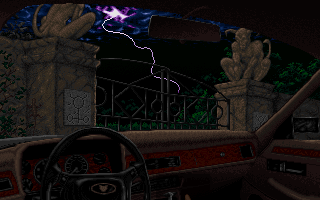 |
| A shot from The Legacy’s opening cinematic. It’s a dark game. |
I think horror also requires a certain attention to location and story that the typical RPG hasn’t provided through the current era. You can set a good horror game in a gothic mansion with 15 rooms, each full of lore. It’s harder to do this in six 20 x 20 levels of similar wall textures. It is thus not surprising to me that most famous horror games have been adventure games. You can take time to craft more thorough stories and locations with adventure games. You don’t need to supply dozens of foes because you don’t need the character to build skills or earn experience points.
Horror games rely more heavily on graphics and sound than other genres. You could write a fantastic horror-themed text adventure, but I doubt you could make a player scream. The same goes for the primitive graphics of the 1980s. It wasn’t until the early 1990s that both graphics and sound (including music) advanced enough on the personal computer that developers could create true atmospheres in games and make a player really feel something in his gut. This is when we started to see an explosion of games that still define the genre: Alone in the Dark (1992), The 7th Guest (1993), Call of Cthulhu: Shadow of the Comet (1993), BloodNet (1993), The Dark Eye (1995), and others that you’ll undoubtedly fill me in on because this isn’t really my area.
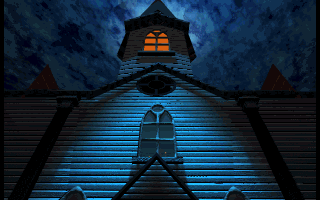 |
| The character approaches the mansion. |
The Legacy comes out of this era, and the best I can say is that it’s about as scary as a horror adventure-RPG hybrid could be, which means not very scary. Sure, the first time you open a door and there’s a zombie, you maybe jump a little, but pretty soon zombies are just another thing to be killed so you can earn experience. The creators did a good job with the mansion except that, as with most RPGs, they made it a bit too big to plausibly be a mansion. The backstory is just a little too derivative of things you’ve already read or watched. It is horror-themed rather than horrifying.
If you can get past that, it’s not a bad game. I had a very enjoyable first session. Mechanically, it’s not unlike a first-person Quest for Glory. The adventure side of the game has a mystery to solve and a variety of puzzles necessary to solve it. The RPG side has a selection of skills and attributes that increase through use or through direct allocation of experience points. There’s enough “extra space” with wandering foes to satisfy the RPG need for combat and character growth. These are the types of features you need for a true hybrid, and not just an adventure game “with RPG elements.”
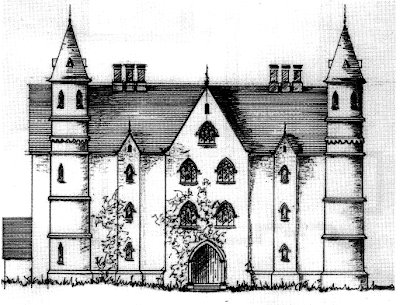 |
| The Winthrop Mansion, as given in the game manual. |
The Legacy comes from U.K. developer Magnetic Scrolls, a relatively long-lived creator of graphical adventures, including The Pawn (1985), Jinxter (1987), The Guild of Thieves (1987; I vaguely remember playing this one in the 1980s), Corruption (1988), Fish (1988), Myth (1989), and Wonderland (1990). The Legacy is the company’s first game with RPG aspirations, although it uses the same basic interface as Wonderland. The commonly-given subtitle, Realm of Terror, appears only on some boxes and not, as far as I can tell, on any manuals or title screens, so I’ve left it off as per my policy. A lot of sites give it as a 1993 game, but plenty of reviews attest to a 1992 release in Europe followed by a 1993 release in North America.
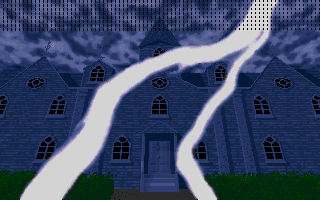 |
| It took me a while to get a screenshot illuminated by lightning. You can clearly see this is not the same house as in the manual. |
The main character is the last surviving descendant of Elias Winthrop (1599-1662), who built the Winthrop Mansion in 1630. The style of house depicted in the manual was built nowhere in New England, probably nowhere in the world, until the mid-1800s. The manual tries to justify this with talk of “extensions,” as if it wouldn’t have been easier to just build a new house than to incorporate a First Period home into a Gothic Revival. Anyway, at some point, the mansion acquired some kind of supernatural curse; the manual claims that Edgar Allen Poe experienced it while visiting a friend, and that it clearly inspired his House of Usher. During his visit–in which the entire family had become sickly and insane–he saw an apparition that screamed, “Melchior! Free me! Perform the rite!”
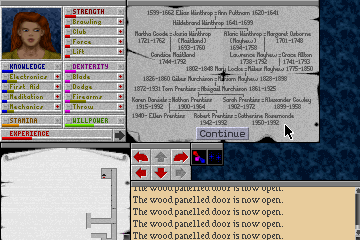 |
| The family tree from the manual is also given in a piece of paper in-game. |
As the game begins, a newspaper clipping claims that three people are “missing” in some kind of undefined “tragedy.” These three are likely Robert Prentiss, his wife Catherine, and his mother Karen, as all of their dates of death are given in 1992 in the family tree included in the manual. Karen had married Nathan Prentiss (died 1964), a descendant of Elias Winthrop through his maternal grandmother. The game’s main character is given as a cousin of Robert, a descendant of Nathan’s sister Sarah, although a graphical “break” in Sarah’s line makes it difficult to determine how much of a descendant.
The game comes with eight pre-made characters from which you choose one. Each has different levels of strength, knowledge, dexterity, stamina, and willpower. Those first three attributes each come with five related skills, such as “Brawling” and “Lift” for strength, “Electronics” and “Mechanics” for knowledge, and “Firearms” and “Throw” for dexterity. Willpower determines your magic ability and whether you start with any spells. The language of the newspaper clipping is slightly modified for each:
- Brad Norris, a sophomore at New York University. Captain of the NYU ski team and member of the Debating Society, Norris is reportedly “planning a mondo party.” He has fairly even skills and attributes but no magic at all. I don’t have any theories to the origins of the name.
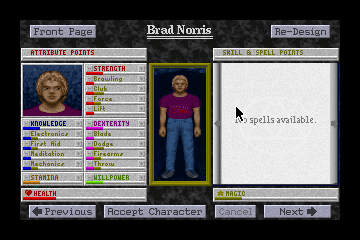 |
| Brad’s statistics. |
- Charles Weiss of Bangor, Maine (yay!), a magician, astrologer, and student of the occult. He has a noodle incident called “the Arlington ‘sacrifice’ scandal” in his past. Balanced in most skills, comes with two spells. The name belongs to a founding employee at Oracle, but I’m not sure he would have been well-known in 1992.
- Charlotte Kane, a New York businesswoman who may be planning to turn the mansion into a luxury hotel and conference center. Strong in knowledge-based skills and comes with “Crimson Mists of Myamoto,” a protection spell. No idea on the name.
- Lucy Weston, a sophomore at UCLA, sorority girl, tennis and volleyball champion. Heavy in strength, dexterity, and associated skills; has virtually no knowledge and no magic. Her name is taken from the character in Bram Stoker’s Dracula.
- Professor Henry Jones, head of the Department of American History at Pennsylvania State University, authority on the Salem Witch Trials. Strongest in knowledge and its skills; not so bad in dexterity; comes with “Sight of the Walker,” which seems to have something to do with dispelling illusions. Naturally named after Indiana Jones’s father.
- Jane Olson, a New York daily Post reporter. Strong in all skills but has no magic. Probably an homage to James Olsen of Superman fame given her profession.
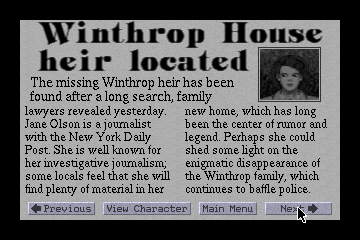 |
| Jane’s version of the newspaper clipping. |
- Major Robert “Boomer” Kowalski, retired from the U.S. Marine Corps after decorated service in Grenada, Panama, and the Persian Gulf. Strongest in strength and dexterity skills; has no magic. No idea on the name.
- Isobel Gowdie, the most mysterious of the characters, described only as a “widow” with an ancestor who lived in the area. Balanced but weak in all skills and attributes but comes with both “Flames of Desolation” and “Sight of the Dark Walker.” Her name comes from the famous Scottish self-confessed witch of the late 17th century.
You can also edit one of the characters, change the name, and define your own. I turned Isobel into Irene, giving her enough willpower for “Flames of Desolation” and “Sight of the Dark Walker,” otherwise favoring knowledge skills but putting a few points into “Firearms.”
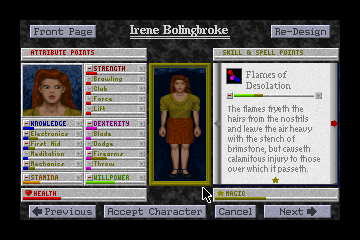 |
| My character. |
The game’s opening cinematic shows a car arriving at the mansion on a stormy night. Glyphs on the main gate posts glow as the gate opens to admit the car. As the approaches the front of the mansion, we see a light on in the cupola. (The mansion shown in the cinematic, it must be said, looks very little like the one in the manual except for the size and a certain dedication to symmetry.) The front door opens into an entry hall, and the view immediately goes up the split staircase and into a dead-end hall before the viewer is consumed by some tentacles coming out of the floor.
Gameplay itself begins in the entry hall, and right away we see that The Legacy features some excellent period graphics. There will be banal, repetitive textures in some of the hallways and less important rooms, but when the game really needs to convey a sense of place like an “entry hall” or a “study,” the artists are up to the challenge, and I find myself wondering again why more era titles (e.g., Wizardry, the Gold Box series) couldn’t have offered this blend of the generic and the specific when the occasion called for it.
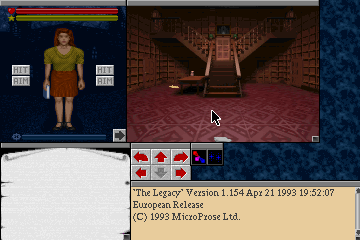 |
| Gameplay begins in the entry hall. |
The engine, known as Magnetic Windows, brings an Amiga or Atari ST-style windows GUI into the game. The windows for the character portrait, exploration, messages, and automap can all be moved, overlapped, and re-sized. Most actions are accomplished with the mouse, in somewhat obvious ways, for instance clicking on an object and dragging into to an open inventory space in the character portrait, or double-clicking on an object to use it. Right-clicking on things brings up a contextual menu, and right-clicking on the “desktop” behind the windows lets you save the game and adjust settings. I wish there were more keyboard backups for some of the actions, such as the “Hit” and “Aim” buttons in combat, but one thing the developers did anticipate is the difficulty using the mouse with the right hand while moving (as in most games) with the numberpad or arrows. Instead, they mapped movement to the QWEASD cluster, which works relatively well.
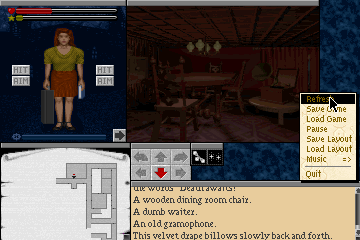 |
| The various windows and game options. |
The game uses tiles in which you can turn and face any direction. Occasionally, for an especially detailed room, you transition to a single-screen view in which you can’t rotate, but that’s rare.
The entry hall is 3 x 3, and the game is spatially sophisticated enough to let you walk under the two upper parts of the split staircase. The front door is magically locked behind me. There are a couple of tables, a statue of a demonic creature behind a glass display case, and a painting from 1662 depicting “the burning of a warlock at the stake.” I am compelled by my history to note that if this was supposed to be a real event, it must have happened in continental Europe because there is no record of anyone accused of witchcraft having been burned in North America, and even England had stopped the practice well before 1662.
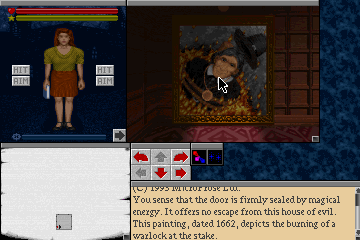 |
| The painting in question. |
There are also a couple of notes on the floor, and as I explored the ground floor of the mansion, I would continue to find more of them. The first, slipped under the front door, was from E. Croxley & Co. Realtors, welcoming me to the house and noting that some of the furniture had been sold to pay for the family’s debts. But the others are from a “Marcus Roberts of Boston,” who clearly preceded me in his explorations of the mansion and has presumably died there. His notes so far have conveyed the following:
- The mansion’s various historical owners have been given to “vile depravities.”
- Every 50 years, disappearances have been recorded in nearby towns at the same time that “strange lights [were] reported in the skies above the house.” The last batch was in 1943.
- Roberts believed the house is possessed by an “infernal entity that is preparing to break through to our world.”
- As he explored, Roberts discovered portals to other planes through which “demons and other monstrous beings” enter the house, particularly on the second floor. I also have him to thank for all the zombies roaming the ground floor, as he apparently released them from the mausoleum.
- At some point, Roberts decided that it was necessary to find something called the Golden Torc, apparently in the lower levels.
 |
| One of the messages from the mysterious Marcus Roberts. |
I started exploring using my normal “right wall” approach and soon found a zombie in a corridor east of the entry hall. Irene had begun the game with no weapons, just a spellbook, so I tried out “Flames of Desolation.” It took three castings to kill the creature. There were more zombies later on, and I ran out of spell power after killing three of them. Spell power doesn’t regenerate on its own. Neither do hit points. The manual is a bit cagey on how exactly you do regenerate these bars. I eventually found a first aid kit that helps with health. Spell points are supposed to be regenerated with meditating, but you apparently have to find some special crystals first. You otherwise do occasionally need to rest and eat, but you can only rest in rooms with a special symbol that I haven’t found yet.
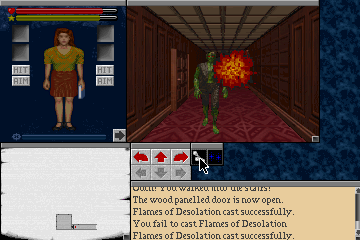 |
| I cast a fireball at a zombie. |
As I ran out of spell points, I tried attacking zombies with my fists. This worked out for a few of them. For physical attacks, you just have options to “hit” or “aim” and then hit. Hitting temporarily depletes an accuracy bar, so you can’t hit a bunch of times in a row without losing accuracy with each successive strike.
You can’t really do a “combat waltz” because enemies in melee range are in your square, not an adjacent one. Trying to side-step to another square requires passing a roll to escape combat first. But I did manage to somehow get one enemy stuck facing perpendicular to me, so I could beat him without retaliation. Later, I couldn’t replicate this. I’d really like to find a weapon, but I’ve got nothing so far. When you attack with no weapon, I’m not sure if the game treats whatever you’re holding as a weapon (e.g., a flashlight) or whether it assumes you’re temporarily dropping that object and using a fist.
I didn’t notice that my fist attacks increased my “Brawling” skill, but my experience bar did increase. It seems to increase a little bit with almost every successful action, including exploring new areas, finding objects, and defeating foes. You can then spend the experience directly on skills or spell power, but I’ve just let it accumulate for now, I guess waiting for the first time I try to use a skill like “Electronics” and it goes poorly.
I’ve been relying mostly on the auto-map so far. Based on it, I’m guessing that the main floor is 20 x 20. The automap annotates rooms and doors relatively well, but it doesn’t do anything with objects, stairs, or puzzles, so I’m probably going to restart and create my own maps, since I use the mapping process to annotate things like locked doors and unsolved puzzles.
You’ll be happy to know that I’ve left the music on. The main theme isn’t really very melodic or insistent. It basically consists of three lugubrious bass notes, a pause, and then either a succession of percussive beats or a non-melodic flutter in a higher register. It has a clear “haunted house” vibe and sets the atmosphere well.
I didn’t deliberately plan this, but it appears that I’m playing The Legacy along with my cousins at The Adventure Gamer. At least, I assume it’s still active. Voltgloss posted an introductory entry on 2 March 2020, but there hasn’t been a second one yet. Perhaps someone from there can clarify.
Time so far: 2 hours
*************
I had intended to return to Ultima VII for this entry, but it’s taking me longer to catch up to where the game glitched than I thought. I’m still devoting a portion of my playing hours to that game, so when I finally do catch up, I’ll stop introducing new titles and pick up where I left off.
Original URL: http://crpgaddict.blogspot.com/2020/06/game-368-legacy-1992.html
